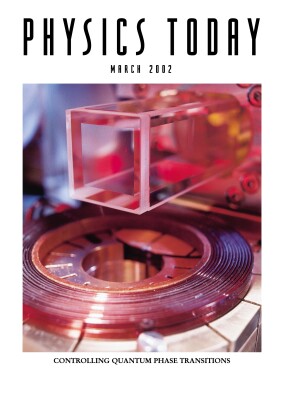One-Time Wolfgang Paul Award Presented
DOI: 10.1063/1.2408465
The Alexander von Humboldt Foundation in Bonn, Germany, presented the Wolfgang Paul Award—only this once—to 14 top-ranked scientists and scholars at a ceremony in Berlin last November. The objective of the award, said the foundation, is to offer the winners ideal working conditions at a research institute in Germany so they may pursue their research projects “free from red tape, while building up their own working groups with highly qualified younger academics in Germany.” Of the recipients, the following work in a physicsrelated field: Ataç Imamoglu, Josef Käs, Alexei Khokhlov, Roberto Ragazzoni, Alexander V. Sobolev, and Andrew Webb.
Imamoglu’s research focuses on investigating the optical properties of nanostructures and their applications in quantum information science. The goal of his research, noted the foundation, is to control and manipulate spin degrees of freedom of an electron confined inside a quantum dot. A professor in both the physics and the electrical and computer engineering departments at the University of California, Santa Barbara, he will be pursuing this work while visiting the University of Stuttgart.
Käs, an associate professor of physics at the University of Texas at Austin, and his research group there have developed laser-based nanomanipulation tools to examine cells and the cytoskeleton. In particular, he has looked at the extent to which changes in the cytoskeleton characterize the progression of cancer. His goals include developing a tabletop device for quick cancer diagnosis and building well-controlled circuits of genuine neurons. Käs plans to conduct his research at the University of Leipzig.
At the University of Ulm, Khokhlov plans to use experiments, theoretical approaches, and computer simulations to develop procedures to enable scientists to design the sequence of biomimetic copolymers in such a way that macromolecules create predictable folds, take on a defined form, and therefore fulfill special chemical and physical functions. He is a professor and also head of polymer physics and crystallophysics at Moscow State University.
At the Max Planck Institute for Astronomy, located in Heidelberg, Ragazzoni will be furthering his work on the use of adaptive optics, specifically to make real-time compensation of turbulence in three dimensions. His goal is to correct astrophysical images over a large field of view; currently, correction is achievable for only a tiny patch around the line of sight of the telescope. Ragazzoni is an astronomer with the Astrophysical Observatory of Arcetri, located in Florence, Italy.
With a research focus on the origins of melts in Earth’s interior, Sobolev, a professor of geochemistry at the Russian Academy of Sciences’ Vernadsky Institute of Geochemistry in Moscow, has developed new approaches for studying the composition and nature of microscopic amounts of melts that are enclosed in the crystals of the mineral olivine. Based on results obtained through this analysis, he has created theories about the nature of melting and the composition of materials deep in Earth’s interior. An understanding of Earth melts is important, because they form the basis for the origin of continents and oceans. Sobolev will be working out of two guest institutes, the Max Planck Institute for Chemistry, in Mainz, and the University of Mainz.
Webb is an associate professor of electrical engineering and an associate professor at the Beckman Institute of Advanced Science and Technology at the University of Illinois at Urbana-Champaign. His research involves using nuclear magnetic resonance to examine the structures and functions of molecules, cells, and organs. He has developed microdetectors that enable scientists to study individual biological cells without contact or side effects. At the Institute for Physics of the University of Würzburg, Webb will continue his work on creating the next generation of NMR spectrometers and NMR tomographs for the chemical and medical fields.
